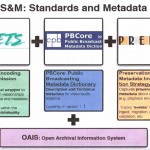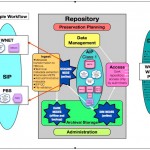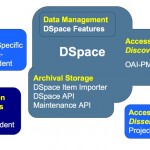Click here to print
Public Broadcasting’s Future and Its Contributions to Broadcasting’s Future
posted January 5, 2011
Nonprofit TV Points to Ways Ahead for Moving-Image Archiving, But Not Everyone Is On Board
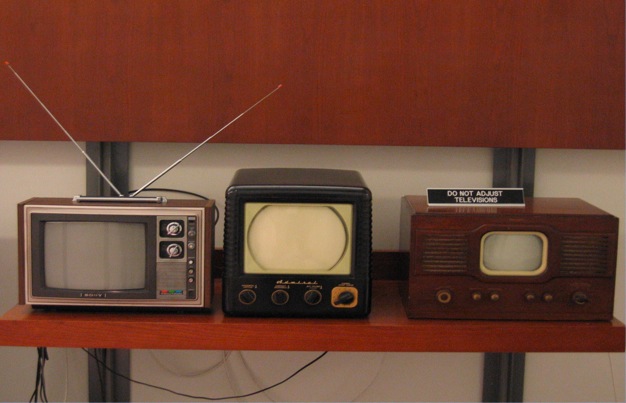
Clearly, television is not what it used to be, thanks to major developments in the way moving images are recorded, edited, stored, viewed, distributed, and everything else.
Tape is dead or at least put on ice; the new day is all digital.
Motivated by that ongoing revolution, public-broadcasting planners have undertaken a broad survey of prospects and challenges.
In fact, as Nan Rubin related in an interview in December 2010 with Moving Image Archive News [recorded December 14 2010] it turns out that public broadcasting may well come to serve as a model for moving-image archives. The public-broadcasting sector is embarked on a brave future in which programming will be packaged, distributed, and viewed in new ways, she says.
Among the most significant outcomes of the work of Rubin’s colleagues, and other archivists around the country, is the American Archive which will address issues of long-term preservation and access to programming materials.
Back in 2004, the Library of Congress, through its National Digital Information and Infrastructure Program, launched the Preserving Digital Public Television project. It was asked to design a model repository for public television – one that would properly preserve programming and rethink how the ways programming is delivered could and should change. The project’s tasks have included determining standards for metadata (a hugely complex task of designing and implementing). As Rubin wrote in her final report for the Preserving Digital Public Television project, “it is not enough to close a digital file and put it on a virtual shelf. For video in particular, acceptable practices to save and access very large files, manage ever-changing file formats, maintain rich and consistent metadata, and protect file view-ability into the future are just now emerging.”
Among the projects’ other tasks have been to explore rights issues relating to video archives, analyze operating costs, and alert institutions within the public-broadcasting community to the importance and potential benefits of good archiving practices.
To those ends, Rubin and her colleagues – bright minds from WNET, WGBH, PBS (Public Broadcasting Service), and New York University’s outstanding moving-image-archiving and digital-preservation programs and services – have released a series of reports. They address such crucial questions as how to deal with the complex copyright issues that new uses of programming would provoke, questions that Rubin discusses in the interview here.
(The reports are available online: Strategies for Sustainable Preservation of Born Digital Public Television; Intellectual Property and Copyright Issues Relating to the Preservation and Future Accessibility of Digital Public Television Programs; Repository Design Report, with attached metadata plan.
{Click on an image to expand}
Back in September 2007, Rubin and co. also released a survey of digital-formatting practices in public television.
And more recently they also released a compilation of links to more than 400 public-broadcasting websites.)
Many of the details in the reports will baffle non-specialists, but in the interview below Rubin explains plainly what we may expect in the foreseeable future of public broadcasting.
How did your committees come about?
We are funded by the Library of Congress. They recognized more than decade ago that this was going to be important for the future of preservation – that they really needed to be able to look at how digital production of content was going to be having an impact on their ability to preserve things and make them available over time.So they really took the lead and put out a call for proposals, back in 2003 asking for groups that had various kinds of content to submit proposals on why their material was important to preserve and what they needed to put in place some kind of a model project for figuring out preservation.
Now within public radio and television broadcasting, we knew also around the same time that digital preservation was going to be critical because all of the production processes, all of the work flows, all the equipment, all of the recording activities and all of the broadcasting activities were shifting over to digital formats – everything, the whole broadcast chain.
It wasn’t uniform in terms of when all the shifts were done. But we knew that they were in the process of happening, and we knew certain things had to be done at certain points.
Such as: 2009, the FCC was going to require all the analog broadcasting transmitters in television to be turned off and they had to be replaced with digital. We knew that. And we could see that in the whole area of recording and editing, all of that was also going digital.
So we knew the broadcast chain was going to be replaced by all-digital files within a relatively rapid period of time. So being able to save that stuff was going to be really important. You weren’t going to be able to play it off the tape any more and stick it on a shelf. That just wasn’t going to work.
So we applied to the Library for one of these digital-preservation grants, specifically because we knew that public broadcasting was going to need that research. We really needed to do that model. And within public broadcasting none of the stations by themselves, or PBS by itself, was in a position to take all of this on alone. It really needed to be set up as a partnership, which is basically what we did.
And at the time it was unusual for the Library because they were not used to funding non-academic institutions, and our proposal when it was submitted was submitted by a non-academic institution, and initially they were a little bit freaked out. They said, ‘Why are these TV stations wanting to be the lead on it; why isn’t New York University the lead? We already know how to work with them.’
But New York University, which was providing our technical support, and repository-design support, they had no experience with public broadcasting. They didn’t have any familiarity with operations or anything like that. Plus, it was our content.
How many other grants of this kind did the LOC give?
They awarded eight grants in the initial round. It was a very broad mix of content. It was social-science-research media databases; it included a lot of geospatial mapping projects; it included a number of projects that were mixed-media sorts of things, archives and various kinds of mixtures of stuff; some library materials – there was one project that was a web-capture project.
Do you have a sense that this sort of preservation that I guess large software companies are working on – on how to capture the masses of data from research, for example.
We were expecting that there’d be a lot of engagement with the commercial TV networks ad commercial producers. We thought that they would’ve already been involved in this and would have made some progress in terms of some of the technical problems that had to be solved. And guess what, they weren’t. … We became a kind of de facto leader in that area.
So one of the things is that there wasn’t a lot of progress that was being made by the commercial producers in the US and that we became a kind of de facto leader in that area. That was a big surprise to us.
At the same time there’s been a significant amount of work done in Europe. And we found that even though we were out front in terms of activities in the US, some of the things that were happening in Europe were significantly ahead of what we needed, in terms of following some of the problems and what kinds of solutions they were looking at.
So we turned to them for some support in terms of what we were doing, and everyone else was trailing us. That was very interesting.
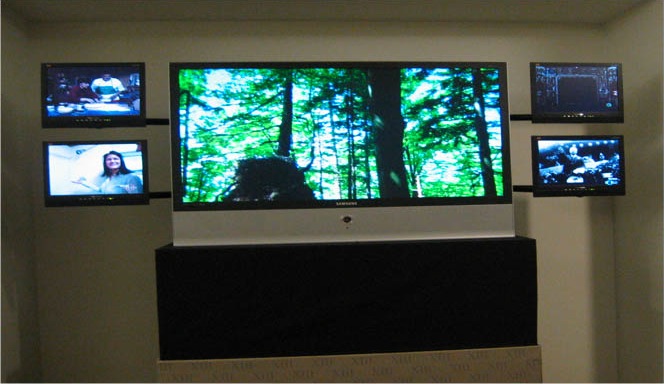
A second thing was that along with the library there were quite a few other initiatives looking at large-scale digital preservation, primarily large data sets of various kinds. Not necessarily moving-image things, which are very large, complex files because they’re time-based as oppose to flat files, and things like that.
There was quite a bit of activity going on nationally among like-minded groups to look into this area of digital preservation. The NSF named what they called The Blue Ribbon Task Force on Sustainable Digital Preservation and Access and they have produced some really excellent reports. They represented a mix of large cultural and academic institutions including the Smithsonian Institution, the Library of Congress, a number of research schools like the University of California San Diego library activities, and some commercial interests like Microsoft. So they were all actually working on this as a major public-private partnership.
And their report which is slightly more of an overview really raises those questions that anyone looking at digital preservation has to approach. We’ve contributed to that.
In terms of public television, specifically, what are your priorities, now? You point out in the reports how large these tasks are, and that centralization is needed because the stations can’t afford to make large changes by themselves, and that preservation hasn’t been the first priority for public television because it has been too busy putting out programming.
That’s right.
How do you stop in your tracks and cater to all of this?
Well, you don’t stop in your tracks. You have to add it. I would say one of the major developments in public broadcasting – and this includes radio as well as television – has been that for the first time the Corporation for Public Broadcasting has actually decided to pick up on preservation as a requirement for what’s going on. Because of this enormous shift in output, this shift into the digital world, it’s become really clear on some levels that there have to be some collaborative steps taken to work on preservation of digital material.
So the Corporation for Public Broadcasting started a pilot in 2008 and got down to serious planning last year to create what they’re calling the American Archive which is a new entity that is going to be created for public radio and TV specifically to take up the issue of long-term preservation and access to materials.
They’re looking at analog collections as well as digital, because there’s a lot of stuff in the can that’s been sitting on peoples’ shelves for 50 years. And there hasn’t been a lot of effort to be systematic about knowing what’s there and being able to come up with some preservation planning.
But at this point, with the digital environment, it became really critical for the system to recognize that it needed to make an investment. So the American Archive is picking up on some of these things.
The American Archive has launched is an inventory project, because nobody knows how much stuff exists out there in public radio and television land.
One of them is a technology and architecture and operating plan to figure out what options are available based on the kind of infrastructure that exist. Because public broadcasting already has a decentralized infrastructure; it has public radio and television stations all around the country. Some of them have significant capacity for doing technical projects and for managing technical activities including file storage and that kind of stuff. So there’s the possibility for using that infrastructure. Plus there’s a distributive infrastructure for file exchange because programs have been exchanged on the networks already, for decades.
And again because our experience has shown us that these things really need to be collaborative in terms of resources, part of the planning is also looking at how to share the operating resources – what it is going to take to bring in funding and operating based on models that other people have.
The second major project that the American Archive has launched is an inventory project, because nobody knows how much stuff exists out there in public radio and television land.
So they’re actually doing an inventory where they’re asking people to submit their count of their collections: What do they have; what are the formats; how old is it; etc. etc.
A lot of people within the broadcasting system who keep saying, ‘why should we care about this? Why should we participate in something like this? How is it going to help us?
The next step is going to be looking at constructing an actual entity for the Archive. I don’t mean bricks and mortar; I mean building some kind of a new functioning institution; some kind of new incorporated institution that is not going to live at any of the existing public-broadcasting institutions. And, what steps need to be taken to begin processing this material into the Archive.
So there’s going to be money for digitizing, etc., for digital and analog material based on some sets of priorities and needs. But that’ll be the next step after the inventory and the technical planning is in place.
One thing that becomes apparent as you talk about this is that in the past obviously some material was kept but people were busy programming, especially in the early days of public radio and TV, but now there’s much more mindfulness of preservation.
I’m not sure I’d agree with you. There are a lot of people within the broadcasting system who keep saying, ‘why should we care about this?’
Oh, really?
Yes; there’s definitely a much higher consciousness, but it’s not universal. There are still a lot of people who say, ‘why should we participate in something like this? How is it going to help us?’
And I don’t think there’s necessarily been a consistent commitment to preservation. In some places, like PBS, NPR, Minnesota Public Radio, and some places like that – some of the larger producing groups – obviously they’ve taken some effort to take care of their own stuff. Not necessarily huge investments. But some of them have made significant effort.
Across the board, things have been thrown out, or erased or taped over, because the resources were expensive and scarce. … The question of selection, and what you keep and what you put into some kind of a system really becomes very critical.
And, on and off, across the board, things have been thrown out, or erased or taped over, because the resources were expensive and scarce.
Now what you have is sort of the opposite, which is that digital resources – apart from storage – but recording things, is really cheap.
You used to have out-takes, people would shoot three to one, five to one, now they’re shooting 50 to one, 100 to one. They’re oblivious. You might say, well, it’s cheap, it doesn’t cost anything, we’ll keep it all; but you can’t catalog that stuff and make it useful.
So then the question of selection, and what you keep and what you put into some kind of a system really becomes very critical.
Is part of the thinking here that the programming is becoming more valuable in terms of re-run possibilities or licensing to other stations, and use online, and other kinds of packaging?
The online environment has really changed that a lot and made different demands, some of which are things that can be monetized in some fashion, and some of which we really don’t know yet.
But within public broadcasting there’s been an attitude not shared by everyone, but largely, to keep things under their control. They’re not yet willing to let things go in ways that might be for public mash-ups and things like that. I’m grossly characterizing, but they’ve had a very particular attitude about being gatekeepers, about controlling their material, etc.
And there’s a lot more pressure now to say, because of the online activities, to let things go a little bit more – to put things up anyway even if all the material hasn’t been cleared, and then just take it down if someone complains. But by and large public broadcasting has been very slow to come around to that sort of attitude and it’s not a universally shared thing.
The American Archive is trying to look into all the questions of issues relating to intellectual property and copyright, so that there can be the possibility of adopting some best practices that might include a little bit looser access to some of the materials, particularly the archived stuff.
You also have orphan works that can really get people messed up and make them not want to make them available, because they don’t know what the liabilities might be.
But all of that is under discussion and hopefully there’s going to be some guidance that the lawyers will be more enthusiastic about, providing broader access rather than more limited access.
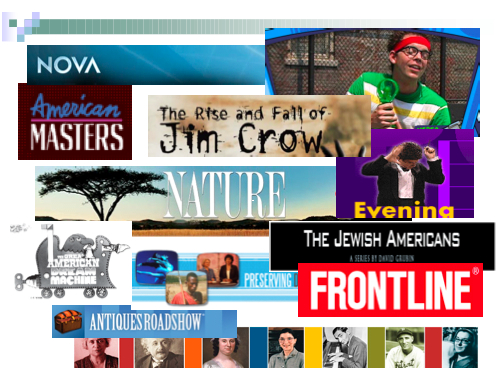
Is there going to have to be a new approach to licensing starting now, in order to sort all of that out? Because producers may later want to ask for permissions to use footage in documentaries, or whatever, are they going to have to start writing their initial licensing agreements more mindful of the future?
That’s already started. But it works both ways – both for the people wanting the licensing, to use the material, and have flexibility in using it, and for the people who own the material, to not be taken advantage of: when they license something to be very clear about what’s allowed and what’s not, and what compensation or not should be put into that. In addition, within broadcasting, some of the licensing terms have been regional or geographic – for example, you have permission to distribute something in the US but not in Europe. The Internet has changed those kinds of things, because you can’t govern those boundaries any more, in terms of where the distribution goes.
The American Archive is trying to look into all the questions of issues relating to intellectual property and copyright, so that there can be the possibility of adopting some best practices that might include a little bit looser access to some of the materials, particularly the archived stuff.
There’s a third element in some of this, in terms of broadcasting, which is that there are union agreements in place on certain things. That also has to change because those agreements dictate some of the conditions under which certain programs might be recorded; they dictate certain conditions regarding reimbursements or royalties that people might deserve because of their role in the production as musicians, as writers, as directors, etc.
And those things have also been long term and locked up with the kind of distribution that was in place prior to the Internet. So that also is another level of discussion that needs to be done in terms of archival material because we’ve got contracts in place and you can’t just go in and change all of that on a whim; that has to be negotiated. And of course they don’t want to give up anything, either, in terms of royalties or rights over materials or restrictions over distribution that might be opportunistic.
There’s that whole level, as well. You might have a symphony orchestra and the contract dictates that everyone gets a share of any royalties, etc. It gets quite complicated.
I wonder about the practicalities of all this: How much progress is possible versus how much is needed. I presume the CPB and all the stations are operating under very restricted budgets, these days, so how is all of this going to happen?
Well, we’ve got to proceed thoughtfully. There are very restricted budgets, but that doesn’t mean there are no budgets. We’re in a period where the economy has been contracting a lot in media. There are a lot of questions about broadcasting. Even though we may not rely on advertising on the air, we have a fairly diverse mix of income sources. We’ve also seen a tremendous rise in demand for the material. The public is much more interested in archives. Other groups that previously might not have thought of getting access to the materials because it was difficult. So that provides the potential for some new interest streams that we haven’t really figured out yet. But they could definitely be in place.
And, we can look at some of the things that other people have been able to do, online. I’m thinking about people like Rick Prelinger and the Library of Congress and Google and the Internet Archive. They have been working in this sphere quite a bit longer than us, so we can see what seems to be working and which things might be appropriate that we can adopt. And also there are some things that we do that are probably not things that are available to them that we could put in place.
So, I think we just have to be creative in thinking about it, and try some stuff out.
I presume you have priorities for the kinds of preservation you want for your programming or new distribution or new ways of showing your material, but I imagine that that’s going to involve an ever-shifting landscape, is it?
Yes, part of it is to be constantly in touch with other people. At AMIA [the annual conference of the Association of Moving Image Archivists] this year, there was a tremendous interest in digital-repository design and trusted-repository criteria. Things like that. Everybody is looking at how to put something in place on their own – what makes it affordable, what needs to be done to make it reliable, and not everyone can afford the same criteria. And there are some very creative things being done in terms of use for the content, based in part on mobile apps, various kinds of linking up things like your map tool with your local restaurant guide, your local cultural institutions. There are a lot of things like that linking together that are being very creative and that you could see, well, we have all this archival material, so how do we do creative thinking with what we’ve got?
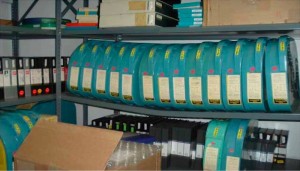 It’s presenting a lot of opportunities. Again, we are seeing in Europe, they’ve been investing for some years on these issues. So we can trail after them. They’ve learned a lot of lessons.
It’s presenting a lot of opportunities. Again, we are seeing in Europe, they’ve been investing for some years on these issues. So we can trail after them. They’ve learned a lot of lessons.
Part of it is very exciting – people are just making things up as they go along, so you have to be flexible. If you’re not afraid of it, it can be very exciting. What I’ve seen in the past couple of years in terms of the moving-image archives has been very exciting. There was a presentation two year ago at FIAT – the Fédération Internationale des Archives de Télévision (International Federation of Television Archives) – where they had basically taken archival material from the Brussels World Fair.
They had film and they had commentary and news clips and they developed an application specifically for the venue where the World’s Fair had been. And they gave people these little hand-held devices, as you might see in a museum, with video and everything, and you could go and walk around the site, and it was linked in with archival material taken at that location, or talking about that pavilion or whatever it was. People loved it; they all wanted to line up and take their families around to it. It was terrific to watch. And it was very exciting to see how people were completely engaged in it.
Another thing that is being done in Europe that I’d like to see done here is that there are several projects asking people to annotate archival materials which can’t be identified, or to contribute and annotate their own.
In Germany there was a project that had to do with when the Berlin Wall fell and the division between East and West Germany fell, and they asked people to bring along their home movies and annotate them. Some of it was boring stuff, but some of it was amazing – when they drove across the border for the first time, for example.
And then one of the other archives in Germany they put unidentified things online and said tell us about these things, tell us what you can about this stuff.
So there are tremendous opportunities there that we haven’t seen before. I’d love to see public radio and TV bet thinking about how something like the American Archive could do some of these projects in ways that would be very exciting, very engaging, and that would get public broadcasting involved in ways it hasn’t been before. I think it could be terrific.
Does that suggest there would be new revenue streams – for example, would they pay for things like those hand-held devices in Brussels?
That particular thing, I think it was a rental, but very affordable because they wanted people to have them in their hands. There’s a lot about how it could be costed out. We’d want to see what that would look like.
But people pay for those audio tours of museums. They rent the devices and walk around. There’s no reason why some revenue couldn’t be raised from some of this stuff, particularly if it was enhanced.
 There are opportunities there that we could never have considered before. My personal opinion is that if we tried some of these things out, if we experimented with them, we could probably come up with some things that would be complete winners, that would be very exiting, really engage the public, and with the possibility of bringing in money, and really show the value of putting this material into some kind of an archive that can be properly accessed and managed.
There are opportunities there that we could never have considered before. My personal opinion is that if we tried some of these things out, if we experimented with them, we could probably come up with some things that would be complete winners, that would be very exiting, really engage the public, and with the possibility of bringing in money, and really show the value of putting this material into some kind of an archive that can be properly accessed and managed.
Interview recorded December 14 2010
Printed from Moving Image Archive News: http://www.movingimagearchivenews.org
URL to article: http://www.movingimagearchivenews.org/public-broadcasting%e2%80%99s-future-and-its-contributions-to-broadcasting%e2%80%99s-future/
Click here to print
